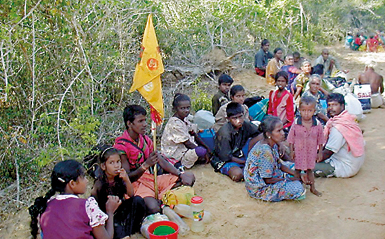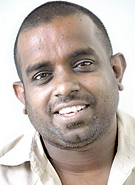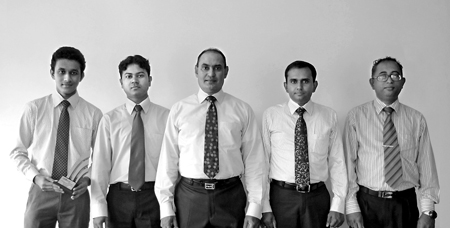Taking big strides in tracking small communities
His foray not only into the wilds but also the towns and cities of Sri Lanka in search of vanished trails leading to near-extinct communities has brought him an unsought boon.
As Nuwan Gankanda, 37, of Irida Lakbima accepted the ‘D.R. Wijewardene Award for Earning the Appreciation of Peers and Public’ at ‘The Journalism Awards for Excellence 2011’ organised by the Editors’ Guild of Sri Lanka and the Sri Lanka Press Institute held on July 31 at the Mount Lavinia Hotel, his thoughts were with the numerous unsung and unheard of “small communities” which enrich the multicultural fabric of this tiny island.

Veddahs at the Deyata Kirula parade
Twenty-three communities, some not even numbering 50, he has brought into public focus over the years through his writings in the Irida Lakbima, after much research.
The names come easily……..the Bohras, the Punjabis, the Memons, the Kojahs, the Parsis, the Malayalees, the Sindhis, the Gujaratis, the Nadars, the Ahamediya Muslims, the Bahais, the Malays, the Bharathas, the Ceylon Kaffirs, the Mukkuwars, the Portuguese Burghers, the Wanni Sinhalayas, the Telugus, the Ahikuntikas (gypsies) and more.
Recently his pen has been documenting the travails of the ‘Mudu Veddahs’ (Coastal Veddahs) who call themselves the ‘Verders’ who have been overshadowed by their better-known cousins of Dambana and Bintenne.It was in 2000 when he was cutting his teeth as a journalist on an assignment covering the General Election that his interest had been roused about “small communities”.
“I was in the office of politician Damu Dasanayake at Anamaduwa awaiting his arrival for an interview when I heard a strange conversation between two men seated behind me. They were fair and looked like Muslims but they were speaking a language I didn’t understand,” says Nuwan.
Intrigued he butted in, asking the two men what the language was. When told that it was Gujarati, his follow-up question had been whether they were from India.
No, they had assured him, they were Bohras and Sri Lankans whose mother-tongue is Gujarati. When Nuwan immediately told them that he was interested in “following up this story”, one of them, Anver Alikhanbhoy, a Colombo businessman, had put him in touch with the Bohra community.

Nuwan’s work brought to light the suffering of the Mudu Veddah community especially during the height of the war in the east
“The Bohras and the Punjabis are into business and have many shops in the Pettah,” says Nuwan. Then he picks out other interesting communities from his long list. Did you know that the Kojahs are a small group of Muslims who have Aga Khan as their spiritual leader, he asks, pointing out that there are no more than 50-60 people in this community. “The Kojahs are big businessmen who own warehouses in Kotahena.”
Next he moves to the Mukkuwars whose ancestors had been a tribe in South India. Small groups had migrated to Sri Lanka long years ago, some settling in Puttalam and others in Batticaloa. Some of them are Muslims while others are Catholics, he says.
Have you heard of the Wanni Sinhalayas, Nuwan asks, giving an insight on this community which lives in the North Central Province. When the Raja Rata collapsed, he says, the people migrated to the southwest of the country, but not all. Small bands remained along the Malwatu Oya, establishing independent villages.
Each village was headed by a Maha Wanniya and a cluster of villages was led by the Wanni Raja. Some of the descendants of this community can still be found in areas such as Kebithigollawa, says Nuwan, pointing out that their culture and also the way they talk are different. Passion tinges his words as he comes to his currently favourite community, the Mudu Veddahs.
It was in 2003 when he joined the Pada Yatra from Panama to Kataragama that he noticed a group which kept to itself, away from the crowds. A Tamil schoolteacher who spoke Sinhala fluently, told Nuwan that they were Tamil-speaking Veddahs from Trincomalee.
Curiosity stirred within him. Nuwan who had never heard of Veddahs from the coast mingled with them and was told that there were more in Batticaloa.

Nuwan Gankanda
Grabbing at this exclusive story, Nuwan who knew only about the Mahiyangana Veddahs begun the “digging” that journalists do. Making a round of calls to the universities, he realised there was no information about them.
Then he pored over Census Reports as far back as 1921 and delved into C.G. Seligman’s book on the Veddahs.The 1921 Census mentioned the Veddahs of Batticaloa and Trincomalee but by 1953 the numbers had dropped drastically. This posed a “loku prashnayak” (big question) for Nuwan as to what had happened. It was then that he started his “walkabouts” in the east in search of the elusive Mudu Veddahs, facing the challenges of being in a conflict area, a quest which has not ended yet. Then he found that in recent times the Mudu Veddahs had been included under the Tamil category.
During the height of the conflict, the Mudu Veddahs who are illiterate and sidelined were a trapped community, laments Nuwan. It was like being between the devil and the deep blue sea. The Liberation Tigers of Tamil Eelam exploited the youth by conscripting them into their rank and file and forcing their aged to cut bunkers, while the security forces unknowingly lumped them with the LTTE. ‘Depaththenma theluna,” he says, adding that they got crushed from both sides.
It is for Nuwan’s work in these areas that the nomination by the Editors’ Guild and the citation at the awards become relevant: ‘For bravely undertaking news assignments notwithstanding the dangers involved so that his peers obtained the coverage for dissemination to the public’.
In the wake of his efforts, the Mudu Veddahs met the inland Veddahs led by Wanniela Aththo in 2008, when he helped the Deyata Kirula organizers to get 23 “small communities” to take part in the opening parade. “This was also a first,” he smiles.
Next was the celebration of the International Day of the World’s Indigenous People on August 9. Earlier only Veddahs from Ratugala, Nilgala, Henanigala and Pollebedde had gone to Dambana but that year Nuwan had taken Mudu Veddahs from about 12 villages for the rituals.
The roots of TMVP Leader S. Chandrakanthan (Pillayan) are also among the Mudu Veddahs, according to Nuwan whose work with them is still not over. He was instrumental in organizing with the support of Dilmah Conservation, the 2011 celebrations of the Indigenous People’s Day in Vakarai, Batticaloa, to bring to the fore the Mudu Veddahs in their home territory. He already had experience, having organised a gathering at Kudagama of Ahikuntika elders from all over the country in January that year.
When he was in the midst of mobilising the Mudu Veddahs for the celebrations in 2011 which were attended by President Mahinda Rajapaksa that Nuwan also came across a “Warige” that was believed to have been extinct. In 1911, Seligman had mentioned the ‘Ambalawa Warige’, explains Nuwan, but it was not heard of thereafter.
However, in the Mankerni village in Vakarai, an old man had mumbled that he was one of them and there are about a thousand left. Nuwan believes he has stumbled upon a lost tribe after 100 years.
Juggling family life with a son who is just three years, publishing a book ‘Api nodanna Lankikayo’ (‘The Lankans we don’t know’) in 2006, engaging in journalism and attempting to finish a paper on the Coastal Veddahs as part of his diploma, Nuwan still goes a-visiting his Verder friends. “I was there for a week just last month,” he adds.
comments powered by Disqus





















